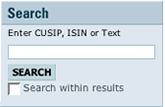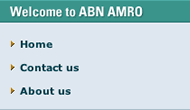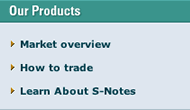|
REX: Calculation of Payment or Delivery
at Maturity
For purposes of this example, assume a one-year Knock-in Reverse
Exchangeable, with a principal amount of $1,000, a 10.00% (per
annum) coupon payable quarterly, linked to the price performance
of an underlying stock that is traded on the New York Stock Exchange
with a closing price of $28.50 on the date the securities were
priced, and a "knock-in level" of 70%, or $19.95.*
Given these assumptions, an investor in this hypothetical Knock-in
Reverse Exchangeable will receive $25 on each quarterly interest
payment date, totaling $100 over the term of the securities, and
the payment at maturity will be calculated on the determination
date as follows:
Step 1: Determine if the market price of the
underlying stock was ever at or below the "knock-in level"
during the period from the date the securities were priced to
and including the determination date, which is typically three
trading days prior to the maturity date.
If the market price was never at or below the "knock-in
level" , the payment at maturity will be the return of
the original principal amount. In this case, investors will
receive $1,000 in cash, irrespective of the closing price of
the underlying stock on the determination date. However, if
the market price of the underlying stock was at or below the
"knock-in level" , go to Step 2.
Step 2: Determine the closing price of the underlying
stock on the determination date.
Step 3: Determine the type of payment or delivery
at maturity.
Compare the closing price of the underlying stock on the determination
date to the closing price of the underlying stock on the date
the securities were priced. If the closing price of the underlying
stock on the determination date is equal to or greater than
the closing price of the underlying stock on the date the securities
were priced, the payment at maturity will be the return of the
original principal amount, or $1,000. If the closing price of
the underlying stock on the determination date is less than
the closing price of the underlying stock on the date the securities
were priced, investors will receive a number of shares of the
underlying stock equal to the stock redemption amount.
Step 4: Determine the stock redemption amount.
The stock redemption amount is equal to $1,000 (the original
principal amount of the Knockin REX) divided by the closing
price of the underlying stock on the date the securities were
priced (i.e., $1,000 / $28.50 = 35.088). Any fractional shares
will be paid in cash in an amount equal to the amount of fractional
shares times the closing price of the underlying stock on the
determination date.
Step 5: Determine the value of the payment or
delivery at maturity.
If the payment at maturity is the return of the original principal
amount, the value of such payment will equal $1,000. If the
delivery at maturity is the stock redemption amount, investors
will receive a number of shares of the underlying stock equal
to the stock redemption amount. The cash value of such shares
will not be determined until investors sell the shares in the
market. However, if an investor were to sell such shares on
the determination date, the cash value would be equal to the
stock redemption amount times the closing price of the underlying
stock on the determination date, which would always be less
than the original investment of $1,000.
Investors do not participate in any price appreciation in the
underlying stock. The total return on the securities will be
limited to the aggregate fixed coupon payments plus the cash
value of the payment or delivery at maturity. The maximum total
return of this hypothetical Knock-in Reverse Exchangeable will
be the original principal amount plus the aggregate fixed coupon
payments of $100, or a total return of 10%. The minimum total
return of the securities will be the aggregate fixed coupon
payments of $100, or a total return of -90%, which will be the
case if the closing price of the underlying stock is zero on
the determination date.
* These assumptions are for illustrative purposes only. The actual
notes offered may have different terms. You should review the
prospectus for the particular offering for a description of the
actual terms of any notes.
Hypothetical Payments or Deliveries at Maturity
In the table below, we have indicated several hypothetical payments
or deliveries at maturity for a hypothetical Knock-in REX, based
on the assumptions set forth below.
* These assumptions are for illustrative purposes only. The actual
notes offered may have different terms. You should review the
prospectus for the particular offering for a description of the
actual terms of any notes.
[ Table: Assumptions ]
[[ Table: Hypothetical payment #1 ]
[[ Table: Hypothetical payment #2 ]
|







